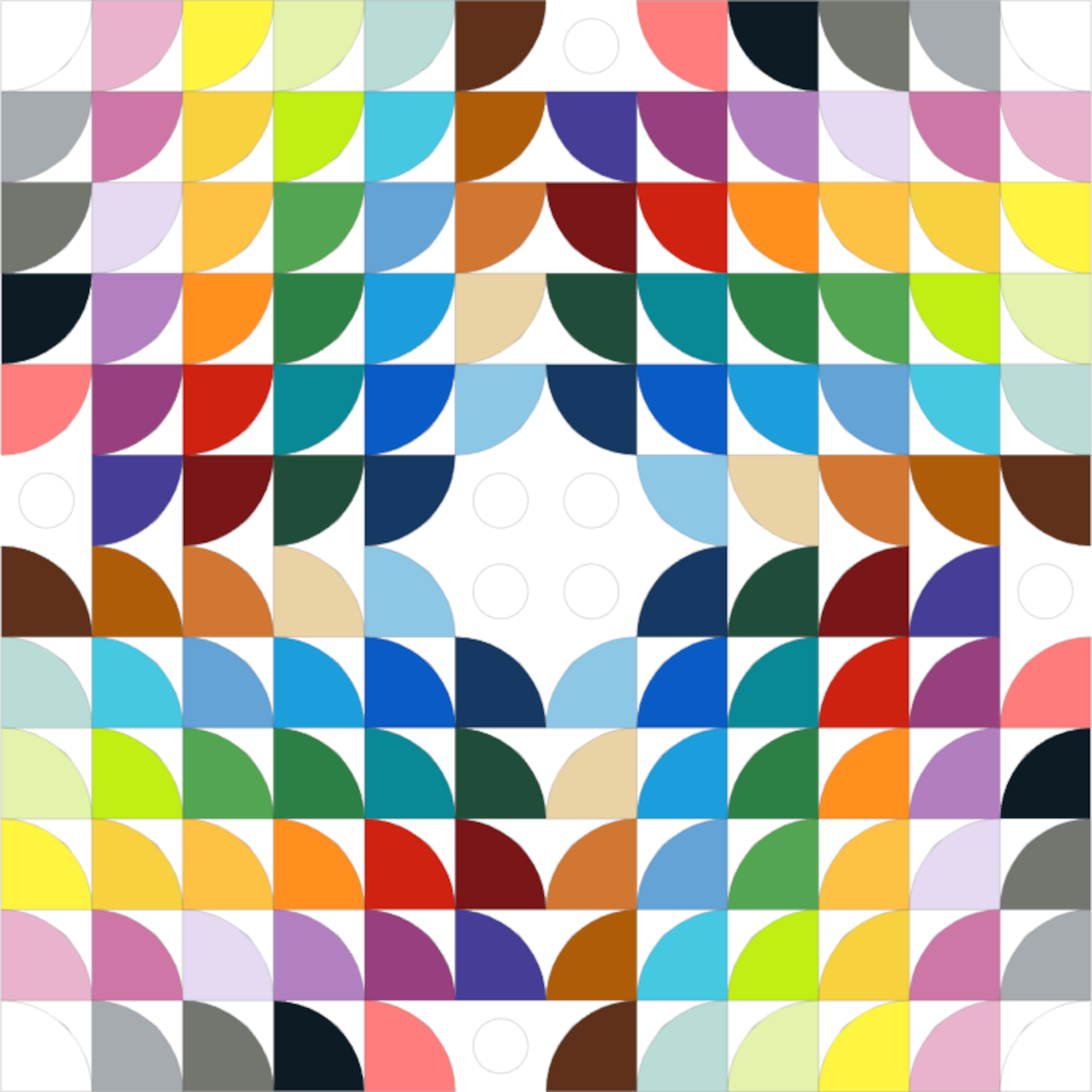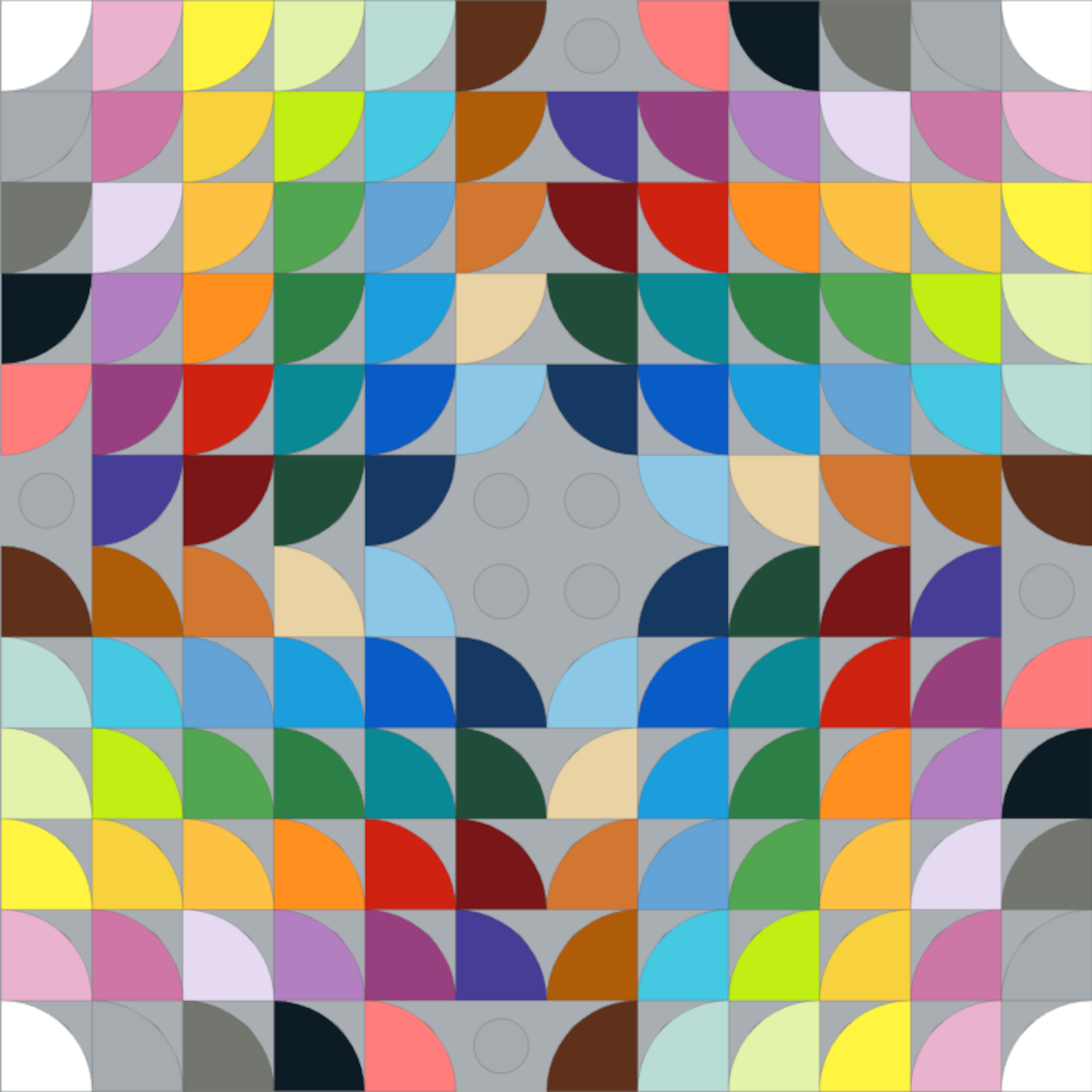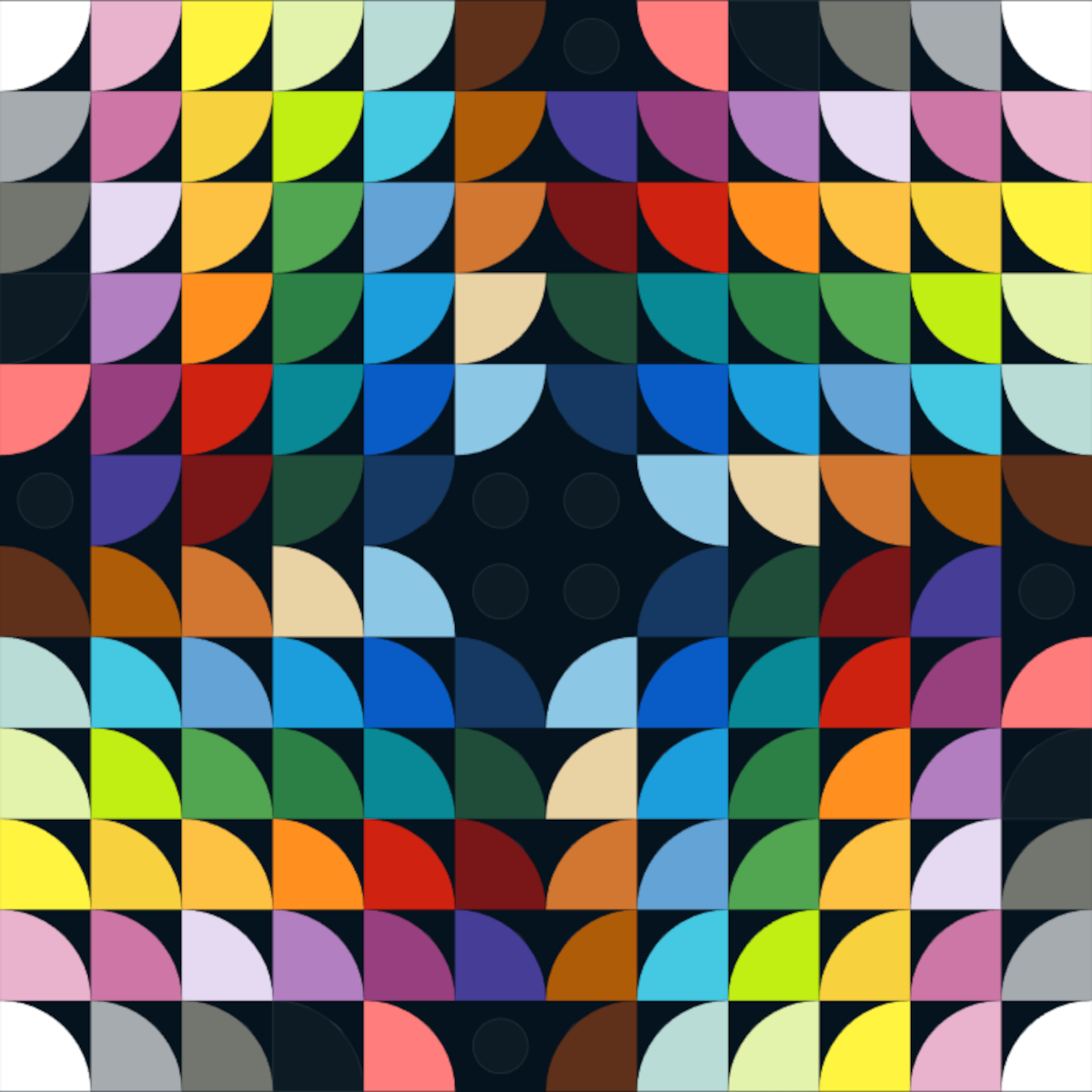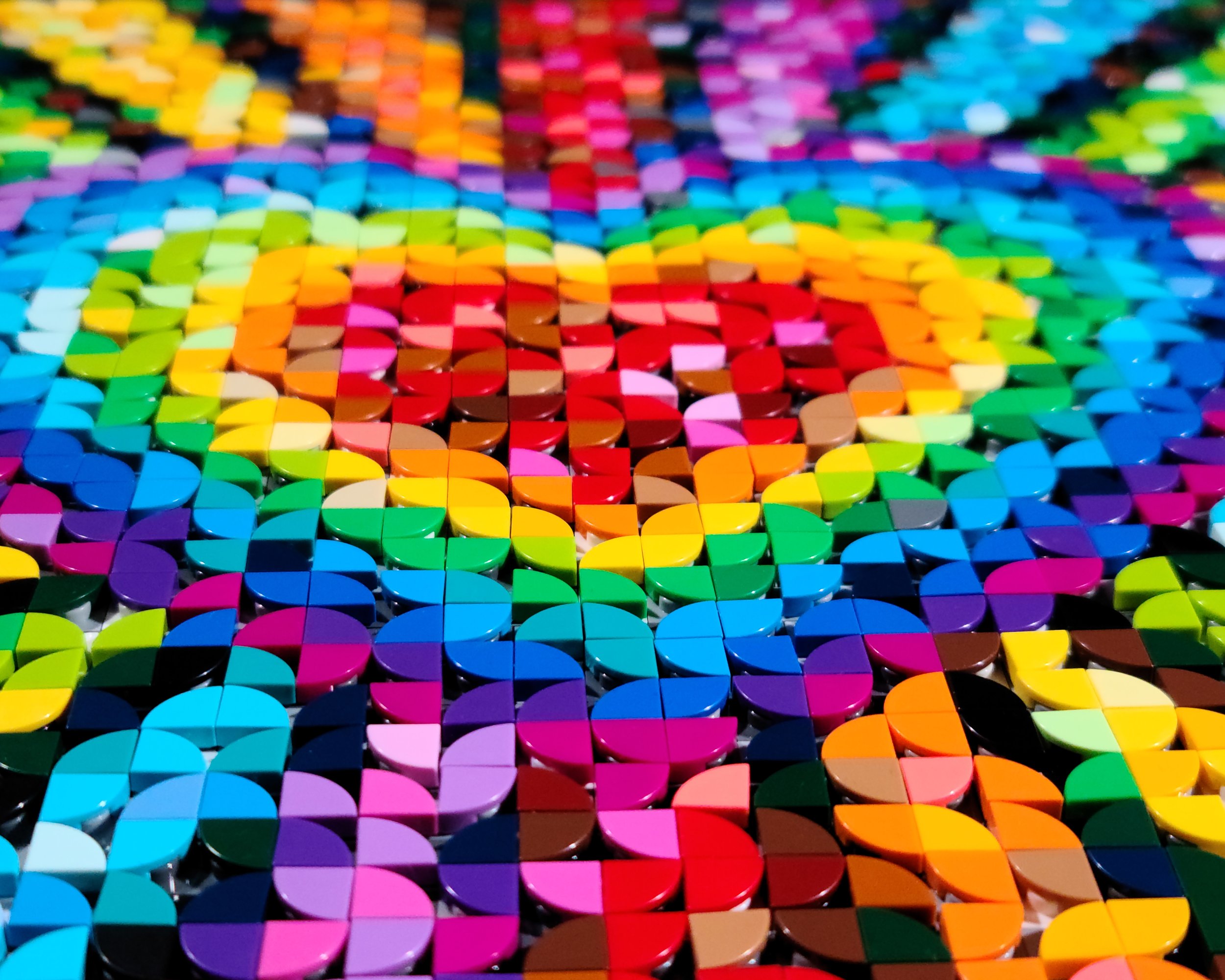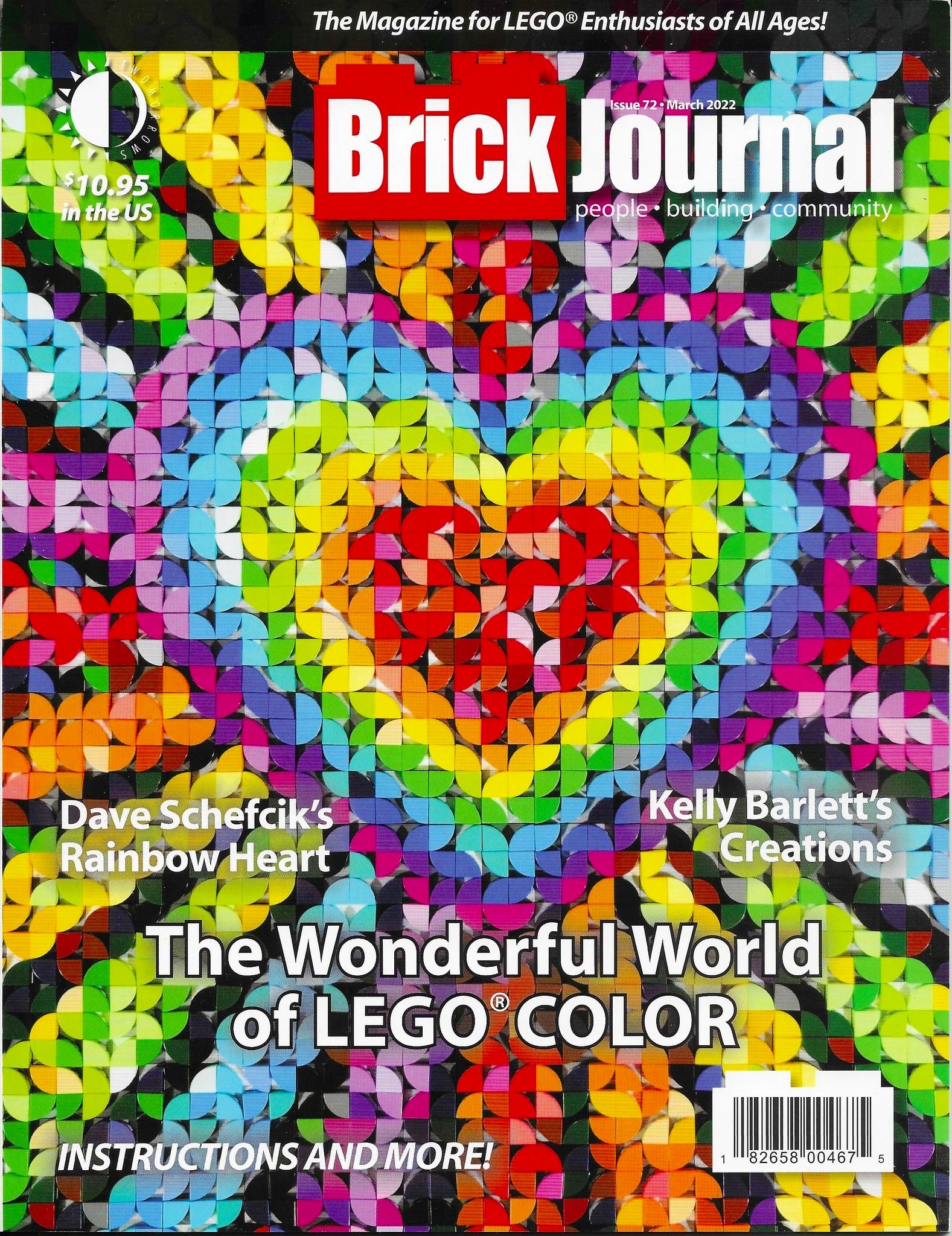Rainbow Heart: A LEGO Mosaic Pulsing with Color
/Best of BrickNerd—Article originally published March 4, 2022 and republished today in honor of LEGO DOTS which is sadly ending its run as a theme later this year.
Today’s guest article comes from Joe Meno. I had the pleasure of being interviewed by him about my Rainbow Heart mosaic for the cover article of BrickJournal Issue 72, available today.
I went to my first LEGO fan convention post-COVID in August 2021: BrickFair Virginia. After over a year of staying home and only virtually attending events, this was a nice step back to normalcy.
There were protocols that had to be done at the event, but it was also an opportunity to meet friends, make friends, and see what everyone built during the pandemic.
One of the creations that got my attention was a mosaic built by BrickNerd-in-Chief Dave Schefcik (Flickr | Instagram). The idea was simple: a heart radiating a rainbow of color. However, what made it interesting was that it was composed of tiny tiles so it had the feel of stained glass. The bigger surprise, though, was seeing it during the World of Lights, where the expo hall lighting is dimmed and illuminated MOCs make themselves known. Dave’s mosaic was lit, and with rotating colors of light, it glowed and pulsed as if alive!
It wasn’t a hard decision for me to request an interview with Dave, so let’s find out about his mosaic: “Rainbow Heart.”
BrickJournal: The design of the heart is so colorful and eye-catching. What inspired you to create it?
Dave: There are a few inspirations behind my “Rainbow Heart” mosaic. First off, there were a few craft stores that had LEGO Dots sets at a really steep discount last summer in the United States. With the help of my LUG (ILUGNY), I was able to get quite a few of the bracelets and extra Dots bags which were fun to sort, but that led me to have an excess of small tiles in my collection.
I thought a mosaic would be a fun way to utilize some of the pieces, but I wanted to try a new technique—using all the small, printed tiles as a way to increase the overall detail. Unfortunately that got very complicated quickly and I realized that even with the sales, I didn’t have enough printed tiles for an entire mosaic.
So I focused on the quarter-circle tiles (or pizza tiles as some people call them) which I had in abundance. I had so many different bright colors that I thought something rainbow-related would really be fun, and Pride month was on the horizon which was an added motivator. I also wanted to create a mosaic that was a bit more artistic and intentional than many of the computer-generated ones you see around, though I used my fair share of technology to create it.
BrickJournal: The technique you used for the mosaic is different than anything I’ve seen before. How did you come up with the technique using the quarter-circle tiles?
Dave: The idea actually came to me all at once. One evening when pondering how to use the element, I realized that a quarter circle tile doesn’t fully cover the entire 1x1 plate beneath it. One corner is exposed. If you consider a 1x1 space on a mosaic to be a pixel, that means that a quarter-circle tile on top of another color could actually increase the resolution of the entire mosaic while still keeping the size relatively manageable. But that meant that I had to build two mosaics on top of each other which would double the piece count.
The quarter-circle tile also has four possible orientations for each corner, so I quickly came to the realization that the possible color and orientation combinations were vast. After a few quick building tests, I found that the quarter circle tiles were great at conveying more organic movement to the static grid of a LEGO mosaic, and I decided that a grayscale underlayer would not only simplify the math but also utilize color theory to add more gradients to the colored tiles when viewed at a distance.
BrickJournal: How did you determine what colors to use for the underlayer and top layer of the mosaic?
Dave: My first step was to visualize all the “pixel” color possibilities at my disposal. Using my target image idea of a heart with radiating bursts of color, I started to map out what each mosaic pixel should be in Microsoft Excel. I dabbled in pixel art growing up, so I created what looked like a giant Tetris board of nothing but corner pieces stacked on top of each other. Splitting each cell into four quadrants, I mimicked the peek-through of the underlayer by changing one corner into a grayscale color that aided in the overall design.
I also wanted the finished mosaic to feel organic and avoid too many patterns and repetition that we sometimes subconsciously create, so I set myself a few rules to guide the process and constrain the possibilities:
No quarter-circle tiles on top of their same color in the underlayer.
No exact same “pixels” next to each other.
A tile color could not be repeated more than three times in a row per instance.
A quarter-circle tile’s orientation could not be repeated more than three times in a row per instance.
No complete circles made with the tiles that might draw focus away from the piece as a whole.
In my LEGO building experience, I’ve found that constraints actually lead to creativity. I feel like I am more creative when I have access to fewer pieces (though I still try to have more on hand!).
With all this in place, I essentially had everything I needed to create an algorithm to scale up the process since pixel art by hand is very time-consuming. Using my Excel mockup as a guide, I utilized BrickLink’s Studio software to generate images of all the readily available colors of quarter-circle tiles in each orientation on top of white, light gray, dark gray and black underlayers. I then split up these images into each “pixel” and layered them on top of my grid to start visualizing what the final result would look like and make what I guess could be considered “instructions” for myself.
After some tweaking by hand and using a critical eye to nail some details, I was able to get my first glimpse at what the final mosaic would look like. It was exciting to see the whole idea and process come together and really encouraged me to keep going.
BrickJournal: Was the actual building process difficult or did it come together quickly once you had your final plan in place?
Dave: It seemed easy at first. I started building by placing the underlayer of plates then the top layer of tiles on each stud as I progressed, but I quickly discovered that my eyes crossed trying to see which grayscale color to place beneath the tile. Instead, I copied down what each of the underlayer studs should be into a notebook and then converted that into an Excel grid which turned into what would essentially be instructions for each underlayer plate. It was fun building these because they reminded me of QR codes. (I scanned one for fun to see what would happen to no avail.)
The quarter-circle tile layer came next. I was able to listen to some podcasts as I built which took about a week of actual building time. (LEGO’s recent Bits & Bricks gaming podcast got me through a lot of the repetitive work.) After it was “finished” the first time, I expanded the design horizontally from a square to more of a rectangle which increased the part count from around 4,500 pieces to 5,500. A MOC is never really finished, is it?
I also had to purchase quite a few quarter-circle tiles from Bricks and Pieces because many of the darker colors and earth tones aren’t included in LEGO Dots sets, and I wanted to include every color produced. I did have more than enough blues and purples though! After that, I had to figure out how to get a photo of it without light reflecting on the many tiles which was much harder than you might expect.
BrickJournal: How has the reaction to your Rainbow Heart mosaic been? I heard you got some special feedback about it.
Dave: I’ve been pleasantly surprised with the reception online—it was the first MOC I’ve made that someone offered to purchase (though it isn’t for sale at the moment). I’ve heard a few people say that they think that it sparkles or even looks like stained glass. Many people say that it is smaller than they expect when they see it in real life (mostly due to the fact that it has more detail in it than would be possible using solid color 1x1 studs).
It also won the 2021 GayFOLs Pride Parade contest which came with the added benefit of hearing the reactions from two prominent designers at LEGO, Mathew Ashton and Jamie Berard. Matthew said it was “eye-catching, powerful and colorful” and “embodies so much positivity.” Jaime called it “playful” and said he “appreciated the artistic side” and being able to “get lost in all the little details.” It isn’t often that AFOLs get feedback from designers in Billund about their MOCs, so I really enjoyed hearing what they had to say. I was also really moved by the people who said the design gave them a little hope for the future.
But my favorite reaction was watching a young kid look at it at a convention this past summer. He spent maybe 15 minutes getting close than walking further away. He’d squint with one eye closed then open both his eyes up as wide as they could go. At one point he even tried to turn his head upside down, then cross his eyes like he hoped a 3D image would pop out of it. His mom was there just giggling at the spectacle after I made eye contact with her. It was so joyful to watch him look at it!
BrickJournal: I’ve had the pleasure of seeing this mosaic in person and can say that it is absolutely luminescent and comes alive, especially with your lighting setup as it changes colors. How did you get that effect to work so well?
Dave: That’s a fun story, actually. I’m sorry to say that the lighting was all a happy accident! I knew I’d be taking the piece to BrickFair Virginia which has a “World of Lights” display where they turn off the main exhibition hall lights to let the MOCs really shine (pun intended). I purchased a small floodlight online to light up the mosaic and cut a hole out of some black felt draped over it to make sure there was no unintentional light bleed onto anyone else’s work.
In the dark, the floodlight really made the heart look almost like it was emanating color from inside the mosaic somehow. I then noticed that there was a control app I could download and discovered that the floodlight could fade and rotate through colored light. I flipped off the overhead lamps in my room and was stunned by what I saw!
Certain colors fluoresced, others seemed to change hues entirely as the colored light cycled through the spectrum. At one point the blues disappeared and the center of the heart popped out, making it almost feel like the heart was pulsing. I was stunned! As much as I would like to take credit for carefully planning how it looks and reacts to light, in this case, it was instead literally unintentional brilliance (pun intended again!).
BrickJournal: With heading the revamped BrickNerd plus your normal everyday job, do you have much time to build? If so, do you have another LEGO project in mind?
Dave: I work in crisis communications so building LEGO helps me relax at the end of a stressful day. I enjoy working on an official set or tinkering with some new parts to explore their geometry and future building possibilities. I also love hearing stories about the culture of LEGO and the AFOL community. So between finding amazing stories to tell on BrickNerd and putting out fires for work, I have a few moments here and there to work on my own creations.
I’ve already begun work designing my next mosaic using the same technique from my Rainbow Heart that I hope to have time to build in the coming year—unless I get an idea for another LEGO project that distracts me!
The article above is featured in BrickJournal Issue 72, along with other colorful LEGO creations from Kelly Bartlett and a team of AFOLs in Poland.
The issue also includes an interview with LEGO designer Chris Perron, a deep dive into minifigure customization, and a feature on how to build a space program.
Copies of BrickJournal are available from TwoMorrows Publishing for $10.95 after creating an account to register for the magazine.
BrickNerd is proud to continue its partnership with BrickJournal by providing feature articles, custom instructions and community support.
What would you do with so many colorful LEGO Dots? Leave your thoughts in the comments below.
Do you want to help BrickNerd continue publishing articles like this one? Become a top patron like Charlie Stephens, Marc & Liz Puleo, Paige Mueller, Rob Klingberg from Brickstuff, John & Joshua Hanlon from Beyond the Brick, Megan Lum, Andy Price, John A. and Lukas Kurth from StoneWars to show your support, get early access, exclusive swag and more.





